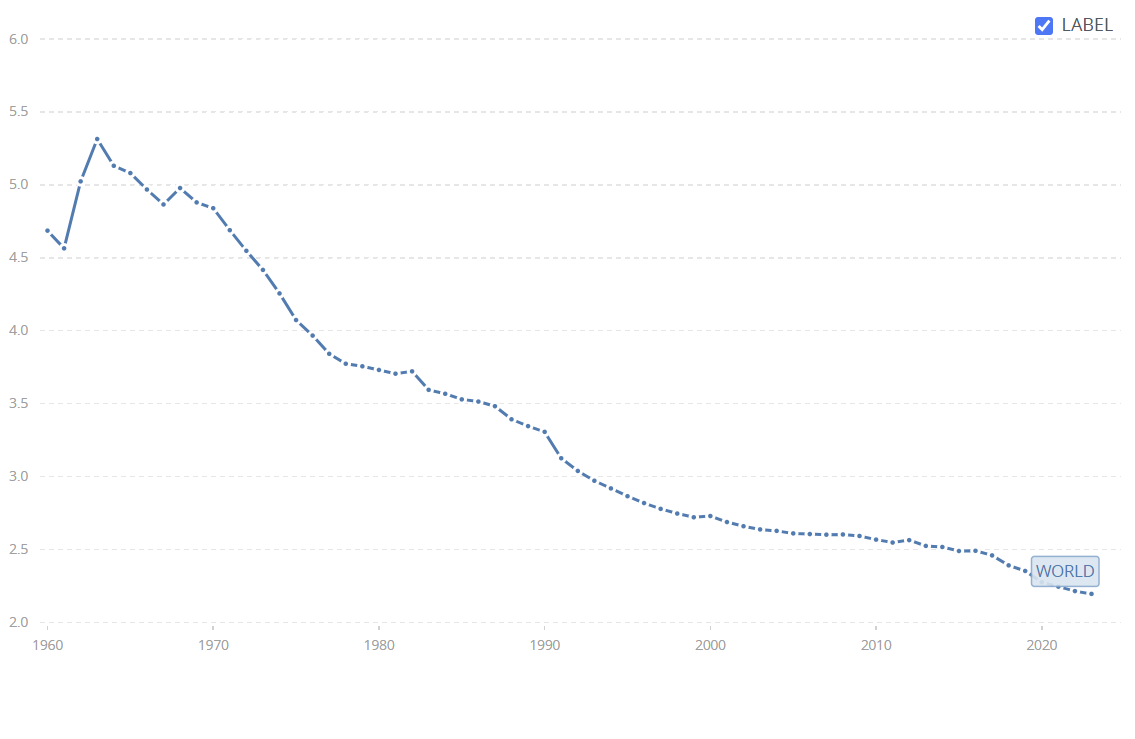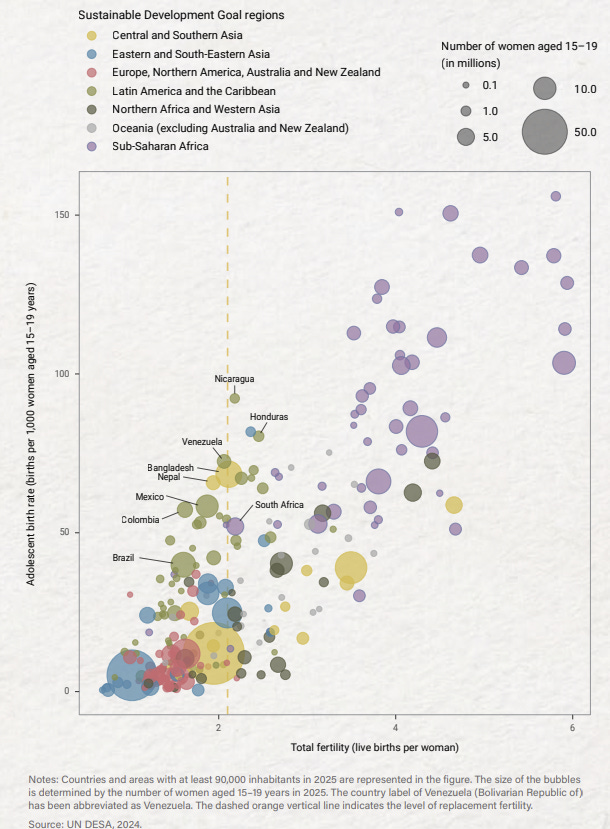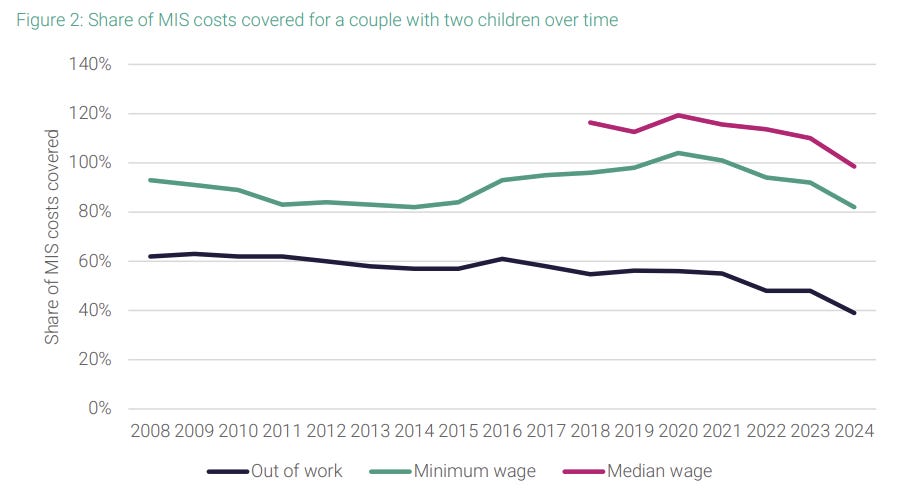Where Have All The Children Gone?
The falling fertility rate is already defining who we are and what we build. It's time to take The Sniff Test.
Migration Won’t Fix a Low Birthrate
In Europe, future generations will be three-quarters the size of the one before. A fertility rate well below replacement results in an ageing population. In turn, this means more government spending and fewer taxpayers to fund it. The default response is immigration, but until the underlying causes of fewer births are addressed, new arrivals compound the problem.
Global fertility has been in decline for sixty years.
The world’s fertility rate remains above the replacement ratio of just over two for each woman of childbearing age. Yet, at least half the world’s population lives in a country where numbers have peaked, or soon will. The fight against migrants may become a fight over them, as countries battle to remain relevant.
The issue is acute in Eastern Asia, where China represents the large blue bubble in the chart below. Then come the countries of the West followed by central and southern Asia, where India is the big yellow bubble. Higher fertility goes hand-in-hand with more teenagers giving birth, which hints at a big reason for lower fertility. Across the OECD a new mother’s average age is over 30.
A Simple Explanation
Academic theory says richer people have fewer children. Healthy and clean populations have low infant mortality, reducing the number of births necessary for family survival. For most of the last sixty years, a richer world and lower fertility went hand-in-hand.
Economists coined two theories to explain this relationship. Quantity-quality says that richer parents spend more on raising children. The cost of education, childcare and even school uniforms rises faster than incomes. Each generation of children is more expensive, meaning parents have fewer kids.
Then there is opportunity cost. Raising children is time consuming and often comes at the expense of a career. The higher an individual’s potential earnings, the greater the sacrifice in having children.
The relationship between income and fertility is breaking down in places. In Europe, higher birth rates in France and Sweden are attributed to government policies aimed at raising fertility. Yet the relationship is also changing in the US, where government family benefits are well below the OECD average.
There is a lot more going on than the old assumption that wealth means fewer children.
Challenging the Consensus
The United Nations State of the World Population Report takes an alternative approach to economic models. For the 2025 report, it asks 14,000 people across 14 countries about their attitudes to children and the obstacles to having a family. The small sample size means this is anecdotal rather than rigorous explanation. Nonetheless, the authors draw two unconventional conclusions.
The first is to question the assumption that it’s women who decide to have fewer children. The survey shows that in every country there are couples wanting larger families and those favouring smaller. Their primary motivations are economic.
By far the biggest reason for not having larger families is financial limitation. Insufficient housing is second. It’s economic insecurity rather than feeling richer that results in fewer children. The UK is not in the survey, but there is a representative spread of countries and the responses are consistent across all of them.
This wouldn’t be a UN report without pastel pictures of same sex couples and attempts to pin low fertility on climate concerns. The survey shows, however, health to be a greater worry. Fear of war and pandemics looms larger than climate, indicating long-term environmental concerns are a privilege of the few.
The second conclusion is a practical suggestion. The appropriate policies to support child bearing are those that make it easier to choose to have a family. Paying people is a crude incentive and does not get to the heart of the many issues at work. People have larger families when they have financial security, access to childcare and comfortable housing.
There are echoes here of the arguments about compensating people for historic crimes. Give poor people money and they spend it on goods and services supplied by rich people. The money roundtrips back into the hands of asset owners and little changes. Lasting change requires the redistribution of assets.
Regardless of your views on guilt payments for slavery, they don’t work. More thoughtful commentators in the black community in the US, believe that equal access to housing is what will make the difference. After all, the slaves and freedmen who escaped the bondage of the South, were excluded from wealthy areas in the North by zoning laws.
We see well-meaning payment policies fail time and again. Raising funding for students translates one-for-one into higher university fees. Add in rent rises and the indebted youth are worse off than before. This leads to calls for more money. The problem is the market power universities have over their customers and, a Sniff Test favourite, the paucity of housing.
The tendency to recommend bad policies undermines some of the best analysis of the problem. The chief culprits are charities. Their glossy reports tell an authentic story of suffering and most often conclude with a call for more government aid.
Social Security Matters
A prime example is the Child Policy Action Group, which produces an important report into the cost of having children. It uses research into the Minimum Income Standard, developed at Loughborough University on behalf of the Joseph Rowntree Foundation. This surveys public perceptions of what is a reasonable standard of living.
This matters because it’s what people think is enough, rather than what the Treasury calculates, that determines whether they have children. The additional cost of raising a child to 18 is £260,000 per couple and £290,000 for a lone parent. This includes childcare, as well as higher rent and council tax that accompany the need for a larger home.
The chart shows that a couple with two children do not meet the minimum income standard when unemployed, or on minimum or median wage. The numbers are worse for single parents, who constitute a quarter of all families with dependent children.
CPAG notes that wages are not adjusted for family size. If they were, employers would favour childless workers. This means social security is important in financing child raising on lower incomes.
The charity concludes by calling for more welfare and higher minimum wages. There are a number of difficulties with this. The primary one is the same as student funding. Giving people more money without increasing the supply of housing and childcare, pushes up the price of both. The next time the survey comes out, families are no closer to meeting the required minimum income standard.
Raising unemployment benefit to cover the cost of a family is the same as paying people to have children. There has to be some incentive to work. Without this, the number of tax payers supporting non taxpayers will fall, which is the problem with a low birthrate in the first place.
Raising minimum wages is more nuanced. If you work full time then it should be possible to raise a family. The chart shows that the adjustment to minimum wages required to meet minimum income is still small. Each increase in the wage, however, likely results in fewer of the jobs that earn minimum wage. The easy option for companies is to demand more migrants and use this supply of labour to cap minimum wages. This only delays the problem of lower fertility and increases the dependence on migrant workers.
Not every economic problem is best solved by increasing supply. The shortage of housing and childcare, however, definitely would be. Not enough housing means no space for families and the resulting choice to have fewer children. Inadequate childcare has the same consequence.
Importing workers without building more homes for them to live in, jacks up the cost of housing for everyone. A major cause of smaller families gets worse. The solution is staring us the face. We even have a government policy aimed at delivering more houses. We just lack a government with the gumption to deliver it.
Spermageddon
I had expected this essay to be about declining sperm counts, WiFi signals and microplastics. You don’t have to look far to see each of these blamed for lower fertility. Yet the evidence is patchy at best.
A 2022 survey of 57,000 men in 53 countries suggested average sperm concentrations fell by more than half between 1973 and 2018. Sperm count fell by more than 60%. The explanations vary, but endocrine-disrupting chemicals are top of the list. These are followed by lifestyle issues such as obesity, metabolic disease and oxidative stress from bad diet.
Other explanations such as WiFi signals and tight trousers are much less convincing. Microplastics and nanoparticles are new areas of research, with no conclusive results to date.
It transpires that the sperm data cannot be trusted. It might have been collected from men struggling to have children and therefore be bias. There is no adjustment for last ejaculation time, fever or summer heat, which can change readings by 30%. A few recent surveys have indicated no decline in sperm count among fertile men. Even if there were, prevailing levels across all surveys remain well above what’s required to conceive a child.
I once read that introducing communal television to villages in India led to marked falls in birthrates. I found only one survey however, from East Germany, claiming television impacted fertility. It argued the programmes pushing the idea of fewer children mattered more than the distraction of a gogglebox.
Villages need electricity to access television. Any correlation between watching Bollywood movies and lower fertility may be better explained by existing theories of rising wealth. This brings us back to the economic incentives and the importance of increasing homebuilding and childcare if we want more children.
The Demographic Doom Loop
The more childless couples there are, the more these policies will be resisted in a form of nimbyism. If you own a house, you don’t want lots of new homes in your area for fear it will reduce the price of yours. If you don’t have children, you question why you should pay for others to have them.
I have borrowed the line that demographics is destiny before. It is a spiralling issue whereby it becomes harder to fix the further fertility falls. This is not just because ever more births are required to get back into balance, but because more votes are cast to protect selfish interests.
It may be that necessity is the mother of invention. AI and robot workers could emerge in time to protect our standard of living as populations decline. In which case, Europe should abandon its fear of technology and invest to catch up with the US and China. If, however, we want to remain technophobes, we need more people.
We are bombarded with the message that if we don’t go green there will be no future for our grandchildren. This is a pessimistic argument, riddled with guesses and the assumption that technological progress just stops. Even with an optimistic view of birthrates from countries like France, Europeans will have far fewer grandchildren. Where is the panic about this crisis?








None of what you wrote is wrong, and certainly the housing nightmare must stymy household formation and all that goes with it. (What a disasters, and how avoidable!). But you missed the obvious: birthrates collapse primarily because of i) availability of contraception, notably the pill; and ii) mass abortion.
I've no desire to get dragged into an argument about the rights and wrongs of abortion just at the moment, but abortion's impact on birth-rates in the UK is unambiguous: latest data shows live births in England and Wales at 605k in 2022, whilst abortions in the same place & time were running at 251k.
Very interesting and pertinent article Thank you
When it comes to analysing the last century or so, the scale of incompetence (if that is what it is ??!) from successive governments of all persuasions over time really does expose failure on a grand scale !
World War One caused the loss of 40 million lives of a global population of 1.8billion in 1914. This was immediately followed by e. 50 million deaths from the Spanish flu pandemic (which Professor John Oxford argued began in 1916 in the trenches https://www.qmul.ac.uk/blizard/about/news/items/spanish-flu-was-ignored-as-a-minor-infection-two-years-before-the-great-outbreak-of-1918.html) and was compounded by a lethal combination of global demobbing and malnutrition caused by the post war food shortage.
Yet it was only the fascist states of Italy and Germany that promoted child birth whilst the rest of Europe and the US concentrated on continued austerity. TS Eliot in the Wasteland already knew in 1922 what was going to happen and as night follows day, the establishment triumph of austerity was only solved by means of a war economy and WW2 resulting in 85 million deaths including 28 million in the Soviet Union alone in a global population that had only recovered to 2.3 billion by 1939
Rinse and repeat the Western leaders continued with the politics of austerity and rationing until the 1950s and even then the rise in fertility rates only experienced an ephemeral gain to around 1965 when it began to fall again as per your observation
At no time have our illustrious leaders, despite every incentive to do so, looked at fertility rates and considered this a problem/crisis, but have seen immigration as the solution
Cynics accuse them of rolling out the Kalergi Plan, and the data is making this harder to repudiate !
Over a century, this cannot possibly be an accident or just incompetence not least because the current UK government seems to have a particular wish to target old and young alike for termination just like the Spanish flu did a century earlier